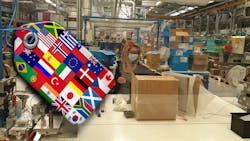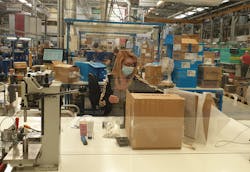Localizing Operations Strengthens Global Manufacturing
Recent global events, including Brexit, the expanded use of tariffs and the COVID-19 pandemic, have led to unprecedented risks and challenges for manufacturers that depend on global manufacturing operations and supply chains. Many companies have enjoyed the significant benefits and advantages of expanding production by building factories around the globe while working with equipment, material and component suppliers in one region while assembling products in another. The aforementioned events, however, have demonstrated that there are risks as well as rewards to these strategies.
A Local Approach
Fortunately, there are strategies original equipment manufacturers (OEMs) can pursue to strengthen their ability to mitigate these risks. The goal is to establish a global manufacturing platform able to respond to changes without imperiling customer orders, lead times or product quality—no matter where production gets done.
At Southco, we supply components woven into many products—automobiles, aircraft, light fixtures, data center enclosures—the world uses every day. For us to succeed and be competitive, we must a global company that is “local” everywhere we operate, serving local customers with locally made products. This is how localized manufacturing can satisfy operational needs, business requirements and each market’s preferences.
Beginning in the 1990s, when we built our first plant outside the U.S., we realized that to be viewed as a local company and trusted, it was necessary to be local. There are clear differences from region to region and customer to customer about what is considered good design, what is the right level of customer service and what local preferences are in how products are supplied to their operations.
For a successful local manufacturing strategy, facilities need to be the right ideal size. This means not putting every type of manufacturing under one very large roof. Consolidating many different processes into a single facility makes material supply, quality control and manufacturing workflows more difficult to manage; staffing also becomes more complex.
Companies should instead strive to make each facility the best it can be in its manufacturing niche. For example, management at an injection molding plant should concentrate only on injection molding. Parts made using different metal-forming processes should be made at separate facilities. This lets teams in each facility focus on improving the quality and productivity of their unique production processes.
Our company also made sure to invest in local design and engineering capabilities. This keeps us deeply connected with customers in each region and gives us insight into that region’s design and performance expectations. It also lets us respond quicker and more wisely to product changes and customization, which is critical in developing our products.
Essentially, each plant has the much same equipment, the same tooling, the same layouts and production flows, and the same procedures whether it is in the U.S., Europe, India or China. So, someone visiting our plastic-injection-molding plant in Concordville, Pa., could be taken to our Shanghai plant and not see any difference (other than language and personnel). They would see the exact same setup, the same flow of goods and materials, and the same quality checking and documentation.
Creating this global network of uniform plants includes investments in connectivity—Internet of Things (IoT)/automation, telecommunications and production data systems. Fortunately, we’ve been ahead of that curve. For example, our plastic-molding machines have been globally networked for 10 years. They have been generating real-time reports on key metrics that are used to manage those machines and production lines.
If you are on the floor of our injection molding plant in the U.S., our Kanban screens show the status of all the molding machines in each of our plants worldwide and provide easy access to details on each machine. This means all lines are managed and supported in the same way. The production is local to satisfy local requirements, while simultaneously operating as a global manufacturing unit.
Along with uniform and consistent procedures, our company invests in the highest levels of training applied across regions. This contrasts with approaches to globalized manufacturing that advocate making some products and components in countries known for being low cost and economizing by using different “low-cost” production processes and workers with lower skill levels.
Most products we make in a region, often more than 80%, are sold and used by customers in that region. We only remain competitive if the quality, performance and value of the products we deliver, and the workforce making them, match the quality expected in all the other regions where we operate.
Our brand of local manufacturing requires significant investments in equipment, planning and management practices. So, we have regional teams responsible for their financial performance of their operations. However, a top-level global management retains responsibility for structure and policy and makes all decisions regarding manufacturing, engineering and design, human resources, sales and business development.
If a regional leader wants to change a manufacturing production or engineering process to perhaps reduce costs, top management assess the approach and decide whether the change can be made globally without risking quality, productivity or customer satisfaction at all of our facilities.
To streamline this, our company has staff at headquarters and in every region that audits process policy and discipline, then proposes and guides productivity improvements. These improvements aren’t driven by what’s best for the factory, but by what regional customers need. At the same time, improvements must align with our global approach to excellence. If an improvement pays off in one location, we determine how it can be used globally.
Surviving Disruptive Events
Our localized manufacturing strategy has made us much more responsive to recent economic events that could have made it difficult to keep our commitments to customers.
For example, the U.K.’s exit from the European Union has gone on now for more than two years, creating a host of unknown risks. There were concerns regarding our ability to work with European customers from our U.K. plant. However, we had already invested in a new production facility in Poland—not due to Brexit, but because it was clear it would reduce lead times and shorten delivery costs for customers in the region by putting production in that part of Europe.
Localized manufacturing acted almost like an insurance policy: Customers interested in using our parts were worried they either wouldn’t be available if Brexit turned out poorly or would increase in cost.
We assured customers we would use the same machines, processes, engineering and customer support wherever the part needed to be manufactured. Having our strategy in place let us tell customers there would be no disruption, even if the company had to move equipment out of the U.K. plant to another.
With the COVID-19 pandemic, our local/global foundation has helped us respond in a coordinated and caring fashion while economic disruptions shut down economies across the globe. Equally important, the global, collaborative culture and business processes we’ve established let us learn early of the events in Wuhan and across China, helping us prepare our plants across the globe.
For example, our plants in Shanghai and Shenzhen needed to carry out a wide range of changes. These included: quarantining any staff that tested positive for two weeks; erecting shields and other physical materials to slow or prevent the spread; establishing effective social distancing practices; using new cleaning/sterilizing practices; and getting personnel protective gear.
These efforts were successful: We did not have a single case of the virus spreading in our China facilities. And since we knew these methods worked, we could prepare to duplicate them in our European, Indian and American facilities. We put technology in place to support working from home, adjusted shifts and social distancing in plants, and made those changes ahead of government directives in most locations.
Lessons Learned
Due to the evolving nature of the current pandemic, it’s difficult to predict exactly what long-lasting changes will need to be made. We know planning and investing in localized manufacturing gave us both the resources and processes needed to quickly identify what to do to adjust operations without significantly affecting our ability to meet customer requirements.
One definite lesson we’ve learned is that viruses don’t respect borders. So, as a global manufacturer, our manufacturing strategy must strengthen our ability to serve customers—whether global or more regional in nature—as best as we possibly can, regardless of the disruptions that arise.
However, one final element is crucial: a culture of honesty and collaboration lets everyone in the organization trust, respect and freely communicate about what it will take for the company, whatever its size, to improve and succeed.
Our core values have never been more important: integrity and professionalism, passion for creating customer value, diversity for to match the global community, inspired commitment, openness and candor, growth and results orientation. In the current situation, these values have been critical to the actions we take.
They are also vital to the localized manufacturing strategy we pursue and continue to. Companies that want to undertake the strategy should know it is not the low-cost path for globalized manufacturing. It requires commitment and long-term investments.
It also requires people who embrace and support a global company culture, irrespective of region or country. Our people and the values they share let us operate as one no matter where manufacturing, engineering, sales and customer service are carried out.
Thomas Mehler is president of Southco, Inc.

